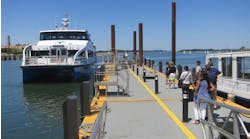The next big thing in commuting is stalled over a quarrel worthy of fashion designers.
The Metropolitan Council pushed back a decision on the design for the new bus rapid transit system in the southern suburbs last week because officials could not agree on what it should look like.
Suburban officials want a distinctive "vibrant" design for the new line of buses hitting Cedar Avenue in November.
But regional transit planners think the color scheme should harmonize with patterns on the buses and light-rail transit in Minneapolis and St. Paul.
"They want to do something that basically is like LRT and like some of the transit buses that they have in the inner cities, and we feel it should look different and more futuristic," said Dakota County Commissioner Paul Krause.
"We want to go back and talk with them about it," said Met Council Chair Susan Haigh, explaining the delay on a decision.
The dispute over exterior design reflects a deeper conflict. Suburban critics of the Met Council say it too often ignores the interests of the localities that help fund the new transit and needs to be more accountable.
A commissioner for Washington County, which is considering bus rapid transit, said the dispute is another reason in favor of the Legislative Auditor's recommendation to replace some appointed Met Council members with elected officials.
"It's not trivial," commissioner Lisa Weik said.
The Met Council says the organization conducted market research, listened to suburban officials at many meetings and made changes in response to suggestions — including killing one design option.
"I don't think their input was completely disregarded," Haigh said.
Yet Dakota County Commissioner Nancy Schouweiler said Met Council staffers at meetings were resistant to most suggestions.
"It made me think they were probably just going through the motions," she said.
The agency's favored design of yellow, red, blue and white patterns would mimic the design of light-rail cars. The color scheme is intended to stress the similarity of bus rapid transit (BRT) to light-rail transit, which surveys show many riders prefer to conventional buses.
Metro Transit director Brian Lamb said the hope is people will regard BRT as "having the same sort of attributes and benefits that LRT has."
Conventional Minneapolis and St. Paul city buses also feature those colors, but a different design.
Not different enough to satisfy Schouweiler or Krause.
"Our goal is to have the BRT vehicles distinctive in appearance," Krause wrote Haigh, saying the rapid-transit buses deserve "more vibrant colors, including additional red."
Schouweiler complained that agency staffers "want to keep their trademark symbols" while suburban officials thought the BRT "could use a little pizzazz."
Local influence
The Met Council bowed to pressure from the suburban critics in withdrawing an option that had too much pizzazz —what critics described as "graffiti" or "scribble."
As council member Steve Elkins recalled, "It was kind of a Rorschach test; everybody saw something different."
But the critics said they ran into roadblocks selling their alternatives. Krause, in his letter to Haigh, said he was writing on behalf of several Dakota County officials "to share our utter frustration. ... It is supremely aggravating to be invited to share thoughts ... only to have the input completely disregarded."
Elkins said he is "kind of shocked" by the criticism, saying the Met Council staff met numerous times with the suburban commissioners in the months before recommending a design.
Schouweiler says the 17-member council, which is appointed by the governor, cedes too much control to a staff not responsive enough to local concerns.
She complained that Met Council member Steven Chavez, whose district includes Dakota County, "didn't know there was an issue" until she wrote him a week ago.
Chavez said he was out of town when complaints were raised and "once I learned about it ... I made sure the key players were aware of commissioner Schouweiler's concerns."
Washington County commissioner Weik and others say the dispute demonstrates a need for county commissioners to play a role in filling some council seats.
Legislative Auditor Jim Nobles recommended similar changes in a report last year. Haigh, in response to the Nobles report, said any change in the council should insure "a real commitment to regionalism."
Rep. Mike Beard, R-Shakopee, chairman of a key transportation committee, sees the quarrel as "a symptom of a larger problem." Beard said he will propose changes to make the council more responsive to local concerns.
But maybe some details are better left to the staff.
"I leave these design decisions to professionals unless I see something that is totally outlandish," Elkins said. Otherwise, "you just wind up with a larger body of people arguing about what color the seat fabric should be."


